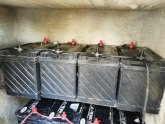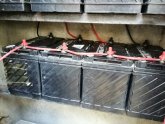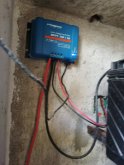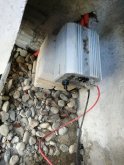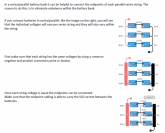Hi All,
Brand new to this forum and would appreciate a little input. We installed a rudimentary solar system on the south east coast of Mexico (where sunlight is abundant 340 days a year) about 14 months ago and have noticed that our discharge rate seems coincidentally weird. I am including a diagram of our current battery setup, which is where the strange numbers occur. I am not at all concerned with our panel setup, since we are fully charged by midday on most sunny or partly cloudy days and seem to have endless energy during the day - we produce up to 5kwh per day. The batteries are all 12v 100ah and are all the same age from purchase. (We would like to add an additional 2 identical batteries into the system at this point - comments on that welcome too). We do not have access to grid power at all!

The above diagram is our current battery setup, however we have noticed that batteries 1,3,5,7 have a higher voltage first thing in the morning (When the batteries have depleted without charge through the night) than batteries 2,4,6,8. the difference is about .5v on average, which creates a zig-zag pattern. Is this purely co-incidental? Are 2,4,6,8 slightly more worn or is this the way it should be? What do we need to do to get them to discharge evenly? I have since read that the positives for both the controller and inverter should come off the same positive pole on the same battery and the negatives off the same pole/battery on the opposite end of the bank. Is this more effective and does it make a difference? Also as a note, the batteries all read the same after a full day's charge and usage - within .08v of each other - around 13v give or take a few tenths... (P.S - the batteries are the sealed type).
Thank you kindly...
Brand new to this forum and would appreciate a little input. We installed a rudimentary solar system on the south east coast of Mexico (where sunlight is abundant 340 days a year) about 14 months ago and have noticed that our discharge rate seems coincidentally weird. I am including a diagram of our current battery setup, which is where the strange numbers occur. I am not at all concerned with our panel setup, since we are fully charged by midday on most sunny or partly cloudy days and seem to have endless energy during the day - we produce up to 5kwh per day. The batteries are all 12v 100ah and are all the same age from purchase. (We would like to add an additional 2 identical batteries into the system at this point - comments on that welcome too). We do not have access to grid power at all!

The above diagram is our current battery setup, however we have noticed that batteries 1,3,5,7 have a higher voltage first thing in the morning (When the batteries have depleted without charge through the night) than batteries 2,4,6,8. the difference is about .5v on average, which creates a zig-zag pattern. Is this purely co-incidental? Are 2,4,6,8 slightly more worn or is this the way it should be? What do we need to do to get them to discharge evenly? I have since read that the positives for both the controller and inverter should come off the same positive pole on the same battery and the negatives off the same pole/battery on the opposite end of the bank. Is this more effective and does it make a difference? Also as a note, the batteries all read the same after a full day's charge and usage - within .08v of each other - around 13v give or take a few tenths... (P.S - the batteries are the sealed type).
Thank you kindly...
Last edited:




